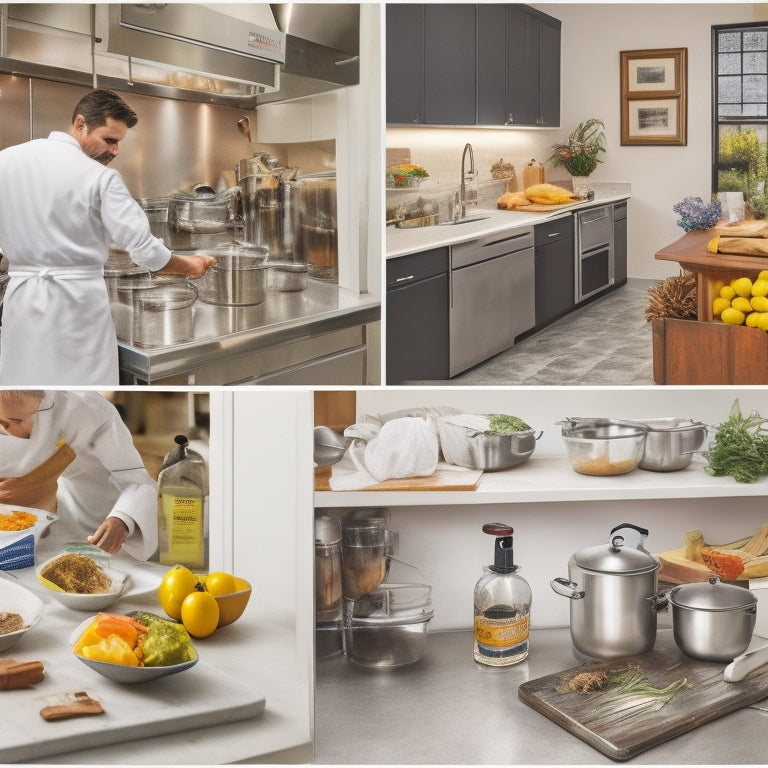
Enhance Food Safety: ServSafe Manager Study Guide
Share
To enhance food safety, foodservice managers must prioritize safe food handling essentials, including proper thawing techniques, preventing cross-contamination, and inspecting food deliveries. Implementing preparation and storage guidelines, such as the FIFO method and shelf rotation, can also help prevent contamination and abuse. Managing food safety risks involves identifying and mitigating hazards, conducting regular risk assessments, and implementing mitigation strategies. Temperature control and monitoring are also vital, with regular checks and documentation of temperatures during all stages. By following these guidelines, foodservice managers can create a safe and healthy dining experience for customers, and discovering more about these principles can further guarantee a safe food environment.
Key Takeaways
• Understand fundamental principles of safe food handling to prevent contamination and ensure a healthy dining experience for customers.
• Implement proper storage and rotation techniques, such as FIFO and shelf rotation, to prevent spoilage and promote safe food handling.
• Conduct regular risk assessments and implement mitigation strategies, such as handwashing stations, to identify and prevent potential hazards.
• Regularly check and document temperatures during all stages of food handling to prevent temperature abuse and ensure compliance with recommended ranges.
• Train staff on food safety protocols and regularly monitor compliance to prevent mistakes and ensure a safe and healthy dining experience.
Safe Food Handling Essentials
Proper food handling practices are essential in preventing foodborne illnesses. It is imperative for food establishment operators to understand the fundamental principles of safe food handling to guarantee a safe and healthy dining experience for their customers.
To achieve this, operators must adopt proper thawing techniques. These include thawing food in refrigerators, under cold running water, or in microwaves, to prevent bacterial growth.
Cross contamination prevention is also critical. This can be achieved by separating raw meat, poultry, and seafood from ready-to-eat foods.
Inspecting food deliveries is another significant aspect. Operators must check for signs of spoilage, damage, or contamination.
Preparation and Storage Guidelines
In addition to safe food handling practices, food establishment operators must also adhere to preparation and storage guidelines to guarantee that food is handled, prepared, and stored in a manner that prevents contamination and promotes a safe dining experience.
Proper storage organization and inventory control are vital in preventing cross-contamination and ensuring that food is stored at the correct temperatures. The FIFO method (First-In, First-Out) and shelf rotation should be implemented to make sure that older products are used before newer ones.
| Storage Guideline | Description | Importance |
|---|---|---|
| FIFO Method | Use older products before newer ones | Prevents cross-contamination and ensures correct rotation |
| Shelf Rotation | Rotate products from top to bottom and back to front | Ensures older products are used before newer ones |
| Labeling and Dating | Label and date all stored products | Helps with inventory control and ensures correct rotation |
Managing Food Safety Risks
Effective risk management is vital in preventing foodborne illnesses. It enables food establishment operators to identify, assess, and mitigate potential hazards in their facilities. A thorough risk assessment helps identify vulnerabilities, such as inadequate handwashing, inadequate cooking temperatures, and poor storage practices.
Mitigation strategies can then be implemented to address these risks. Examples include providing handwashing stations, calibrating thermometers, and ensuring proper storage protocols. Compliance monitoring is essential to ensure that risk mitigation strategies are being followed.
Corrective actions must be taken promptly when non-compliance is identified. This may involve re-training staff or modifying procedures. By managing food safety risks effectively, food establishments can greatly reduce the risk of foodborne illnesses and guarantee a safe dining experience for customers.
Temperature Control and Monitoring
Temperature control and monitoring are critical components of a food safety system, as they directly impact the prevention of bacterial growth and the inactivation of pathogens. Effective temperature monitoring techniques involve regularly checking and documenting temperatures during receiving, storage, preparation, and service.
Food safety audits should include temperature control checks to verify compliance with regulations.
| Temperature Control Point | Recommended Temperature Range |
| Receiving and Storage | 40°F (4°C) or below |
| Hot Holding | 145°F (63°C) or above |
| Cold Holding | 40°F (4°C) or below |
Cold chain management is essential to prevent temperature abuse during transportation and storage. Temperature log documentation provides a record of temperature control, allowing for prompt identification and correction of any deviations.
Preventing Contamination and Abuse
Proper food handling and preparation practices are only as strong as their ability to prevent contamination and abuse, which can occur at any point in the food safety system. Effective prevention requires a holistic approach that addresses cross contamination prevention, proper sanitization, handling allergens, and mitigating foodborne illnesses.
To achieve this, implement the following measures:
-
Separate raw and ready-to-eat foods to prevent cross contamination.
-
Sanitize all surfaces and equipment regularly to prevent bacterial growth.
-
Identify and label allergens to guarantee proper handling and storage.
- Train staff on food safety protocols to avoid mistakes that can lead to foodborne illnesses.
Frequently Asked Questions
How Often Should Food Safety Training Be Conducted for Staff Members?
'An ounce of prevention is worth a pound of cure.' To maintain a safe food environment, food safety training should be conducted every 6-12 months, considering staff turnover, to guarantee all staff members are knowledgeable on the latest procedures and guidelines.
What Is the Recommended Temperature for Storing Cooked Leftovers?
For ideal Leftover Safety, store cooked leftovers at a refrigerated temperature of 40°F (4°C) or below within two hours of cooking, ensuring Cooked Temperature control to prevent bacterial growth and foodborne illness.
Can Food Establishments Reuse Single-Service Utensils?
'Absolutely not! Reusing single-service utensils is a recipe for disaster, compromising Utensil Sanitation and inviting cross-contamination. Instead, opt for Disposable Options to guarantee a pristine dining experience, safeguarding customer health and your establishment's reputation.'
Are There Specific Guidelines for Handling Food Donations?
When managing food donations, guarantee safe receipt and handling by verifying Donation Sources, implementing Food Rescue protocols, and following guidelines for receiving, storing, and distributing donated food to prevent contamination and maintain food safety.
How Long Can Cooked Rice Be Safely Stored in the Refrigerator?
When it comes to cooked rice, careful storage practices are essential to prevent food waste and guarantee safety. Cooked rice can be safely stored in the refrigerator for 3 to 5 days, provided it is cooled promptly and maintained at 40°F (4°C) or below.
Related Posts
-

Deighton Associates Awarded for Excellence in Asset Management
You're likely curious about Deighton Associates' recent recognition for excellence in asset management. They've recei...
